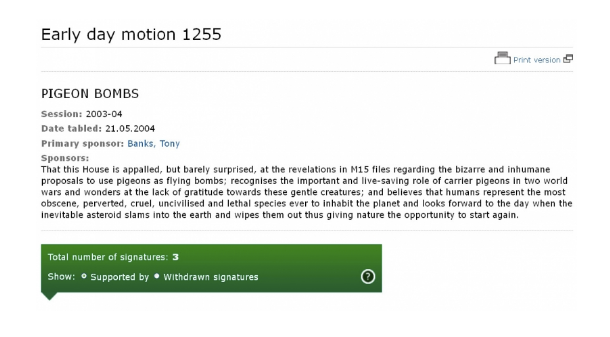Treasonous plotters don’t need to do much more than wait these days - the Houses of Parliament seem finally to have turned themselves into a death trap. Mould coats the inner walls, masonry crumbles from the outer, and asbestos coats the bits in between. Behind the un-fireproofed corridors mice knaw at thickets of cables. When it rains, the lights flicker on and off.
A couple of years back, just to ratchet things up a bit, they acquired some predators: two falcons, brought in twice a week to scare the pigeons off the terraces and squares. It’s a world heritage site, so can’t be pigeon proofed, (which involves putting up nets or spikes), and hawks seem to do the job. “But what people don’t realise”, says Mark Bigwood, a House of Commons falconer, “is that these birds are dangerous”.
Falcons have a long history in London - they arrived around AD 860 and the Tower of London still bears Anne Boylen’s falcon crest - and a short one in Westminster, where they arrived in 2005. Dangerous or not, in the last ten years birds of prey have grown more popular as pest controllers, and are now used at various heritage buildings across the country.
The two used in Westminster are brother Harris hawks - the quickest learners - and each took about a month to train. One is named Denison, after Edmund Beckett Denison, the designer of Big Ben, and the other Angel. They are as obedient as sheepdogs (although sometimes the wind whips them right across the Thames), but onlookers are warned not to touch them - their claws, says Bigwood, can do quite a lot of damage.

At times, the birds will fly so low they clip the tops of policemen’s helmets. Tourists visiting parliament often get a fright “when they realise the birds aren’t stuffed”, and releasing large birds of prey amongst the House of Commons dining tables has its downsides, Bigwood says. “You do sometimes get MPs screaming on the terrace”.
They seem to work, though. 50 to 60 pigeons used to squat above the Strangers Bar terrace, which is where MPs go to have lunch or evening drinks, and pigeon droppings had started to corrode the stonework. Now they mostly leave it alone, although occasionally the hawks will catch one, and pluck and eat it on the side of the House of Commons, in which case you get an inconvenient “cloud of feathers coming down”.
All this comes at a price - the latest figures supplied by the Parliamentary Estate put the annual cost of birds and handlers at £12,678. A further £1,235 is spent removing pigeon droppings. (Repairs to the buildings currently cost about £50 million a year).
MPs have mixed thoughts: some like them, and some do not, although Bigwood won’t elaborate further. But one MP who must surely be in the anti-camp is Jeremy Corbyn, who loves pigeons: in 1996, he implored Westminster council to view them as “friends rather than enemies”, and in 2003, hearing of MI5 plans to use pigeons as flying bombs, he stepped things up, now looking “forward to the day the inevitable asteroid slams into the earth”.
In fact he has wavered from this principle just once, when in 1999 his political ally Ken Livingstone tried to reduce the number of pigeons in Trafalgar Square - that year Corbyn tabled a motion to control pigeons by reducing their food supply.
There are plenty of Westminster bods who like the hawks, Bigwood says, but it’s important the birds learn early to keep these types at arms length. Various officials always ask to hold them, says Bigwood, “but of course that’s not allowed”. “We have to keep them unfriendly or they’d never get to do their jobs.” Theresa May would surely approve.

